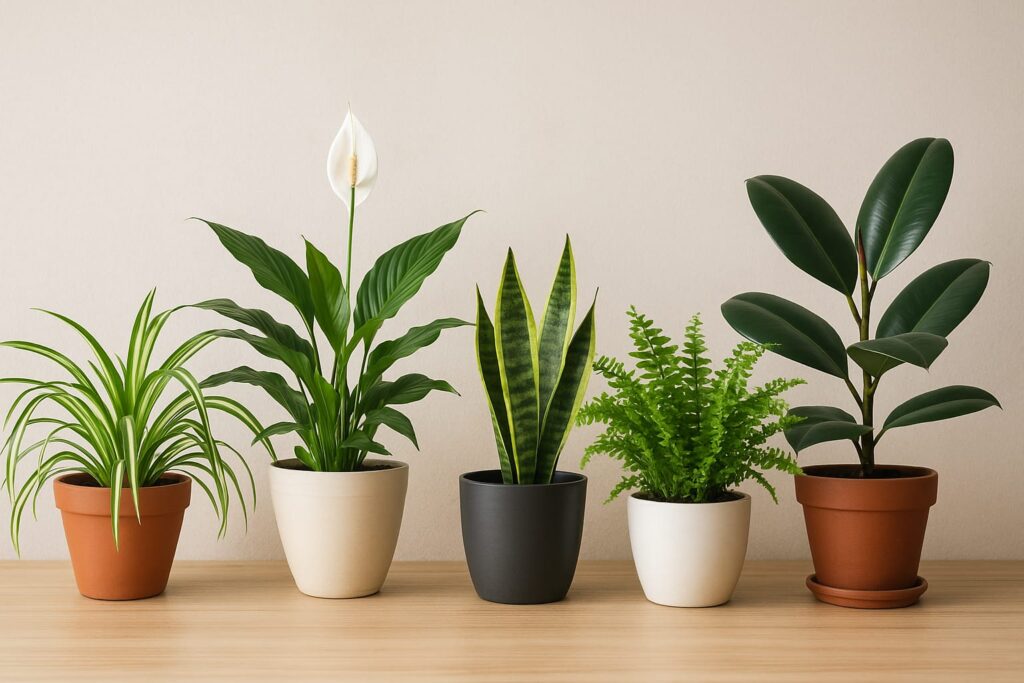Best Indoor Plants for Air Purification
Indoor air quality is often more polluted than outdoor air due to dust, toxins, and chemicals released from furniture, cleaning products, and everyday activities. For anyone concerned about creating a healthier home, incorporating the best indoor plants for air purification is an effective and aesthetically pleasing solution. These plants not only beautify your space but also filter harmful substances, producing cleaner air for you and your family.

Why the Best Indoor Plants for Air Purification Matter
Airborne pollutants such as benzene, formaldehyde, and trichloroethylene are commonly found indoors. While air purifiers can help, plants offer a natural, cost-effective, and eco-friendly alternative. In fact, NASA’s Clean Air Study highlighted several species capable of removing significant amounts of indoor toxins. Additionally, these plants contribute to humidity regulation and stress reduction, creating a more comfortable environment.
Top 12 Best Indoor Plants for Air Purification
Below are some of the most effective plants that clean indoor air while requiring minimal maintenance.
|
Plant Name |
Pollutants Removed |
Light & Water Needs |
|
Spider Plant (Chlorophytum comosum) |
Formaldehyde, xylene |
Bright, indirect light; water moderately |
|
Peace Lily (Spathiphyllum) |
Benzene, ammonia, formaldehyde |
Low to medium light; keep soil moist |
|
Snake Plant (Sansevieria trifasciata) |
Formaldehyde, nitrogen oxides |
Low to bright light; water sparingly |
|
Aloe Vera (Aloe barbadensis miller) |
Formaldehyde, benzene |
Bright light; water when soil is dry |
|
English Ivy (Hedera helix) |
Benzene, formaldehyde |
Bright light; keep soil slightly moist |
|
Areca Palm (Dypsis lutescens) |
Formaldehyde, toluene |
Bright, indirect light; water regularly |
|
Boston Fern (Nephrolepis exaltata) |
Formaldehyde, xylene |
Indirect light; high humidity, frequent watering |
|
Rubber Plant (Ficus elastica) |
Formaldehyde, airborne chemicals |
Bright, indirect light; water moderately |
|
Gerbera Daisy (Gerbera jamesonii) |
Trichloroethylene, benzene |
Direct sunlight; water regularly |
|
Bamboo Palm (Chamaedorea seifrizii) |
Formaldehyde, benzene |
Low to bright light; water consistently |
|
Chrysanthemum (Chrysanthemum morifolium) |
Ammonia, benzene |
Direct sunlight; keep soil moist |
|
Pothos (Epipremnum aureum) |
Benzene, formaldehyde |
Low to bright light; water moderately |
1. Spider Plant (Chlorophytum comosum)
The spider plant is resilient, adaptable, and ideal for beginners. It effectively removes formaldehyde and xylene from indoor air. Since it thrives in indirect sunlight, it fits perfectly into almost any room. Moreover, it produces small offshoots, allowing you to propagate new plants easily.
2. Peace Lily (Spathiphyllum)
The peace lily is not just elegant, it’s powerful at filtering pollutants like benzene and ammonia. Its white blooms brighten interiors, and it thrives in low-light conditions. However, remember to keep it away from pets, as its leaves can be toxic when ingested.
3. Snake Plant (Sansevieria trifasciata)
Also called mother-in-law’s tongue, the snake plant is nearly indestructible. It absorbs toxins such as formaldehyde and nitrogen oxides, even at night. This makes it an excellent choice for bedrooms, as it continues producing oxygen in the dark.
4. Aloe Vera
Beyond its air-purifying abilities, aloe vera provides medicinal gel for burns and skin irritation. It thrives in sunny spots and is especially effective at removing formaldehyde. Additionally, its thick leaves store water, making it drought-tolerant.
5. English Ivy (Hedera helix)
English ivy can climb or trail, making it a versatile decorative element. More importantly, it filters benzene and formaldehyde effectively. However, it prefers cooler temperatures and requires regular pruning to prevent overgrowth.
6. Areca Palm (Dypsis lutescens)
This plant not only removes toxins but also acts as a natural humidifier. Its feathery fronds bring a tropical touch indoors, and it thrives in bright, indirect light. As it grows, it can fill empty corners beautifully.
7. Boston Fern (Nephrolepis exaltata)
Boston ferns are excellent at removing pollutants like formaldehyde while adding lush greenery to your home. They prefer humidity and indirect light, making bathrooms and kitchens ideal locations.
8. Rubber Plant (Ficus elastica)
The rubber plant is known for its large, glossy leaves that absorb airborne chemicals efficiently. With minimal care, it can grow into a stunning indoor tree, becoming a focal point in your living space.
9. Gerbera Daisy (Gerbera jamesonii)
Though often treated as an ornamental plant, the gerbera daisy is excellent at removing trichloroethylene. Its vibrant flowers brighten any space, and with proper sunlight, it blooms for extended periods.
10. Bamboo Palm (Chamaedorea seifrizii)
The bamboo palm is a popular choice for both homes and offices. It removes airborne toxins while adding a calming, tropical feel. Furthermore, it’s safe for pets, making it an ideal family-friendly option.
11. Chrysanthemum (Chrysanthemum morifolium)
Known for its bright blooms, the chrysanthemum also ranks high in air purification. It’s particularly effective at removing ammonia and benzene. However, it requires direct sunlight for best results.
12. Pothos (Epipremnum aureum)
Pothos is one of the easiest plants to grow and is highly effective at filtering indoor pollutants. It tolerates low light and infrequent watering, making it perfect for beginners.
Caring for the Best Indoor Plants for Air Purification
While these plants are low-maintenance, they still require basic care to thrive.
- Lighting: Match plant species with appropriate light levels: low, medium, or bright.
- Watering: Overwatering is a common mistake; check soil moisture before watering.
- Cleaning Leaves: Dust can block pores, so wipe leaves occasionally to maintain their filtering ability.
- Repotting: Refresh soil every year or two to provide fresh nutrients.
Health Benefits Beyond Air Purification
Keeping the best indoor plants for air purification offers more than just cleaner air. They can help reduce stress, improve focus, and even lower fatigue. In work-from-home environments, having greenery nearby has been linked to increased productivity and better mood regulation.
Where to Place the Best Indoor Plants for Air Purification
Strategic placement ensures maximum benefit:
- Living Room: Position large species like areca palms or rubber plants in corners.
- Bedroom: Opt for snake plants or aloe vera to improve nighttime air quality.
- Kitchen: Place Boston ferns or pothos to counteract cooking fumes.
- Bathroom: Peace lilies and ferns thrive in humidity-rich environments.
How Many Plants Do You Need?
NASA recommends at least one medium-sized plant per 100 square feet for noticeable improvements. However, more plants can enhance both air quality and visual appeal. Balance aesthetic preferences with practicality.
The Science Behind Air-Purifying Plants
The purification process works through phytoremediation: plants absorb toxins through their leaves and transport them to their roots, where microorganisms break them down. Additionally, stomata on the leaves capture airborne particles, helping to reduce dust levels.
Potential Limitations and Safety Considerations
Although the best indoor plants for air purification contribute positively, they are not a complete solution to poor air quality. They work best when combined with good ventilation. Also, some plants may be toxic to pets or children if ingested, so always research species before bringing them home.
Final Thoughts on the Best Indoor Plants for Air Purification
Incorporating these plants into your living spaces is a simple yet powerful way to improve indoor air quality. From the hardy snake plant to the vibrant gerbera daisy, each species brings unique benefits. With proper care and strategic placement, they can transform your home into a healthier, fresher environment.
